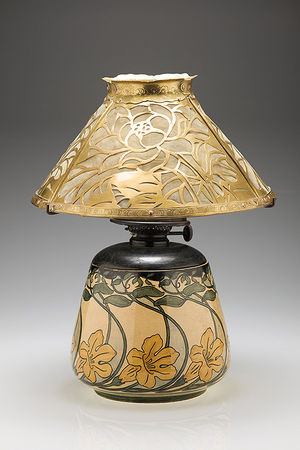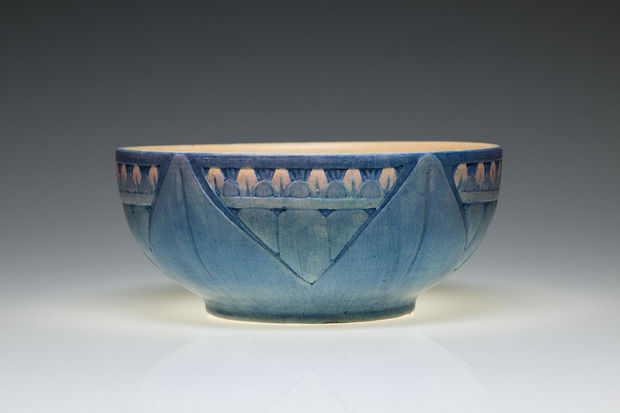Stepping Stones: “Women, Art, and Social Change” at Tulane University
Tasia Kastanek reviews the group show “Women, Art, and Social Change: The Newcomb Pottery Enterprise” at Tulane University.

Esther Huger Elliot (decorator) and Joseph Meyer (potter), Lamp with shade, c.1902. Ceramic base, painted underglaze of “cat’s claw vine” design. Cut out brass shade with copper screen in magnolia design by Elizabeth Goelet Rogers Palfrey. Courtesy Newcomb Art Collection, Tulane University, New Orleans.

Corinne M. Chalaron (decorator) and Joseph Meyer (potter), Bowl with Tiered Abstract Leaf Design, c. 1925–26. Low relief, stylized cotyledon design. Courtesy Newcomb Art Collection, Tulane University, New Orleans.

Harriet Coulter Joor (decorator) and Joseph Meyer (potter), Plate with Cactus Design, c. 1903. Incised, underglaze with glossy glaze. Courtesy Newcomb Art Collection, Tulane University, New Orleans.
“Women, Art, and Social Change: The Newcomb Pottery Enterprise”
Newcomb Art Gallery
Tulane University
October 3, 2013–March 9, 2014
Through more than a hundred objects dating from 1896 to 1940, “Women, Art, and Social Change: The Newcomb Pottery Enterprise” traces the development of a uniquely Southern brand of pottery and crafts. The exhibition emphasizes the growth of the Newcomb aesthetic, but more interestingly roots that aesthetic and its elegantly painted and sculpted ceramics in the revolutionary spirit of woman’s suffrage.
As part of Tulane University’s women’s college, the Newcomb program educated female artists in pottery design and other crafts such as needlework, calligraphy, metalwork, and bookbinding. Newcomb also provided employment for graduates of the school and championed itself as a “model industry,” giving women a modest wage when few opportunities were available.
By 1900, only five years after the program’s inception, the designs were a sought-after commodity, in part due to an award from the Exposition Universelle in Paris, and only continued to grow in popularity. As an early Newcomb professor Mary Sheerer stated, “The whole thing was to be a southern product, made of southern clays, by southern artists, decorated with southern subjects.” Thus crepe myrtle, live oaks, southern pines, frogs, dragonflies, and numerous flower types populate the vases, cups, and plates. In a 1929 vase made by Anne Frances Simpson, subtly detailed moss and light green foliage cascades over sinewy blue tree trunks creating a sense of “Southern mystery” that attracted many collectors. The motif of a moon peeking from behind a moss-draped live oak was so popular that even the decorators began to tire of it. Collector demand, however, ensured that it and other naturalistic images remained a prominent motif for years, even as the approach to line, color, and finish shifted.
Toward the closure of the school in 1940, the artists discarded more realistic renderings of nature, enlisting the luminous glazes for abstracted forms which still managed to evoke the Gulf South. In the “Grand Isle” design vase by Sarah A. E. “Sadie” Irvine and potter Jonathan Brown Hunt, circa 1933, painted lines of lime green edged in pink transition to lines incised in the pale blue ground that sweep around and envelope the vase. The transformation of forms from the palm frond stems around the top rim to the wave-like rhythm of the lines circling the vase recalls a tropical environment while evincing Irvine’s skill in modulation of color and line.
While the richness of the objects leave no question as to the accomplishments of the enterprise, references in the wall texts to market pressure, low wages, and the maintenance of gender division reveal the constraints placed on the women’s artistic endeavors. From the founding of Newcomb pottery, only men performed more physical tasks including throwing pots, firing kilns, and mixing clays and glazes. Even so, the female artists spent eight to ten hours working and only received market value of pieces after the cost of material, firing, and the operating costs of the college. One decorator, Sabina Elliot Wells, outlined the inconsistency in a letter to her mother in 1904: “I am supposed to be one of their cleverer designers and I will make this month $40.00 and last month $30.00 – and that at a pottery where the theoretic pay is $100.00 per month!” Her indignation suggests resistance to then perceptions that young, white women in the South did not need a livable wage. In highlighting the socio-economic conditions of Newcomb pottery, the exhibition underscores the dedication of the artists, as well as the pioneering yet still precarious position of the enterprise. Nevertheless, these lovely and delicate objects functioned as stepping stones for the Newcomb women on the decades-long road to suffrage and personal autonomy.
“Women, Art, and Social Change: The Newcomb Pottery Enterprise” is on view through March 9 at Newcomb Art Gallery, Tulane University, New Orleans.



